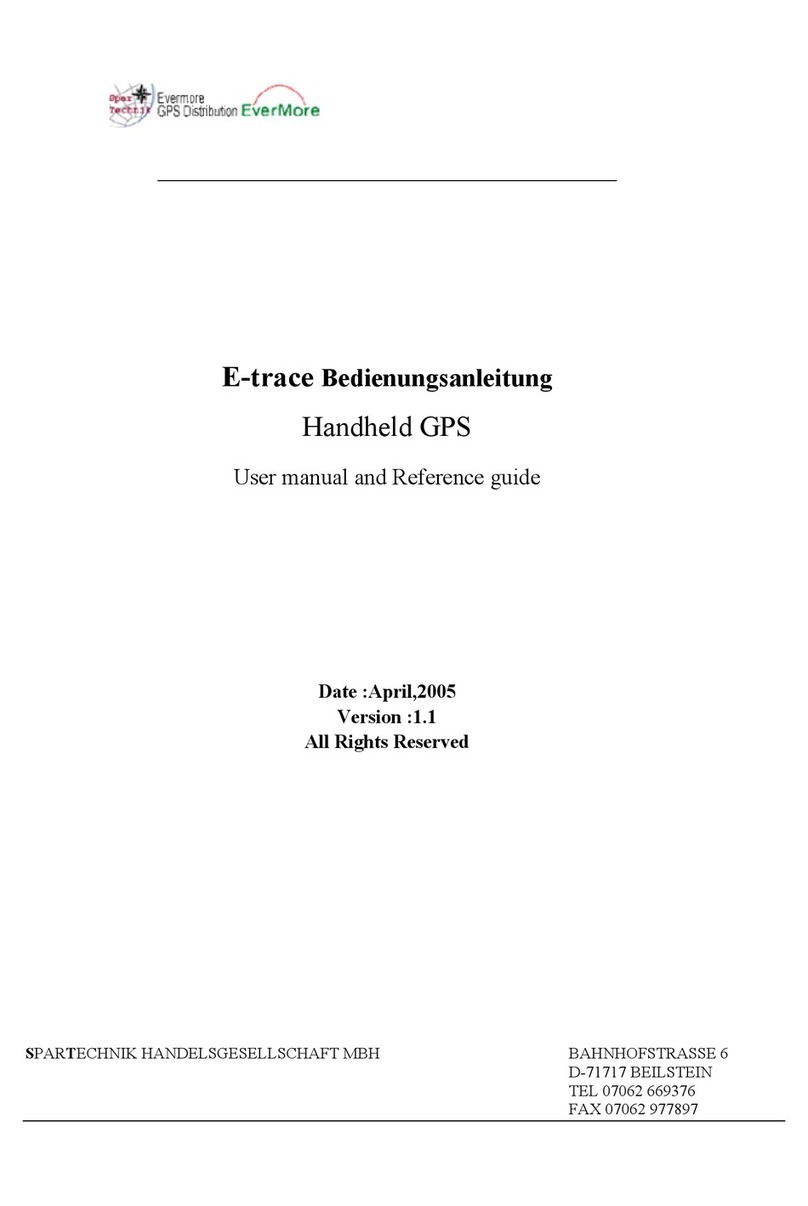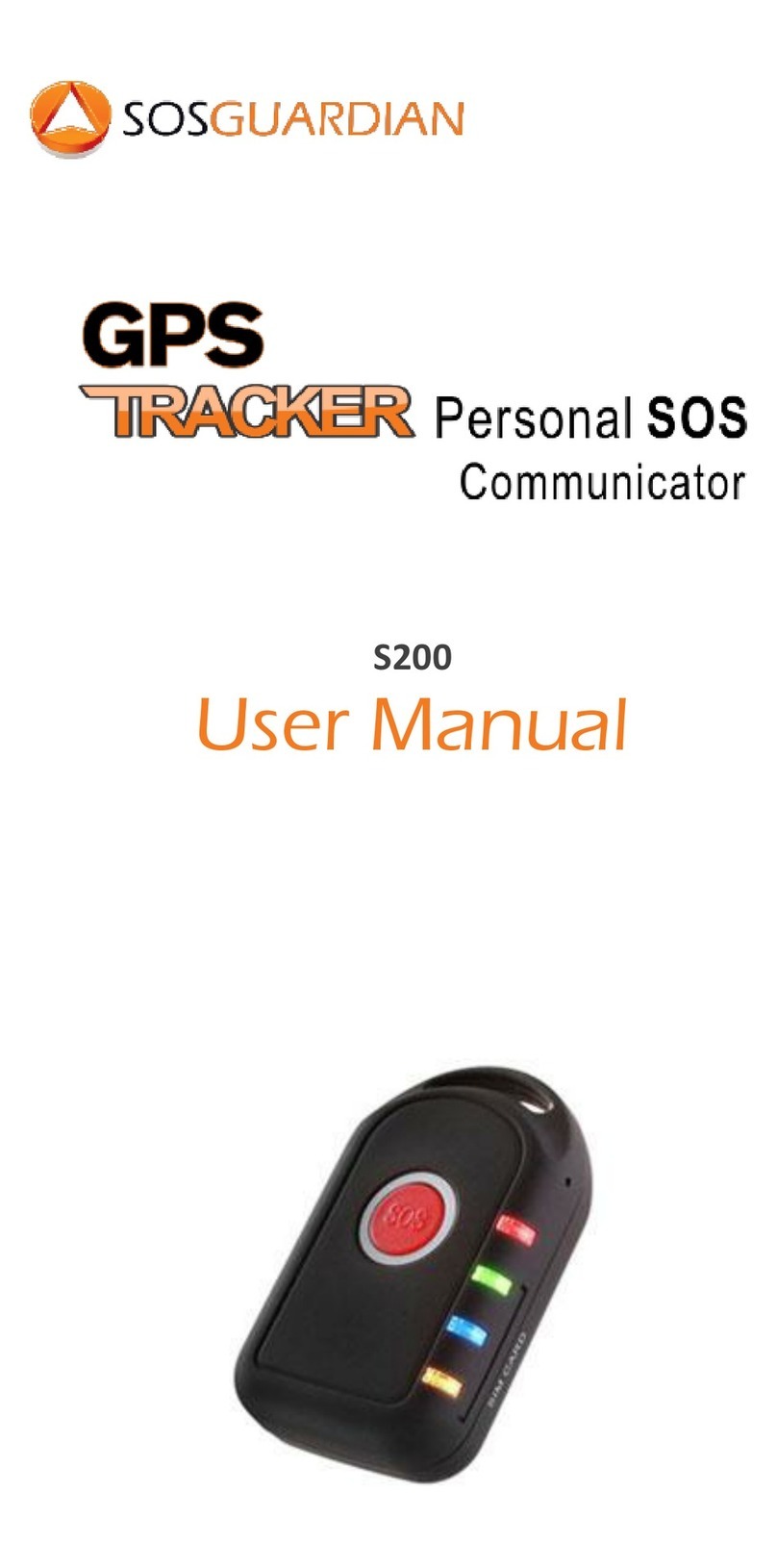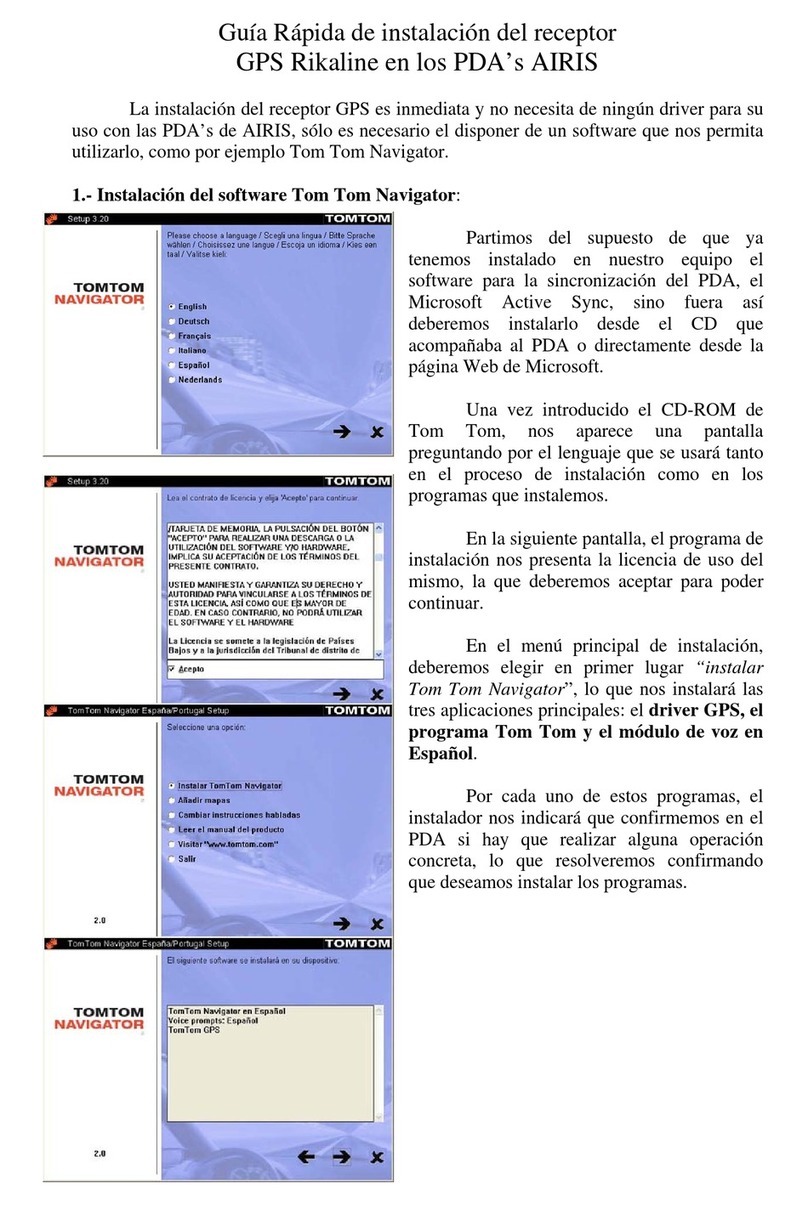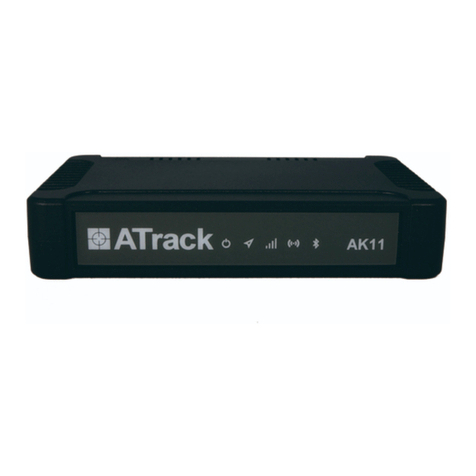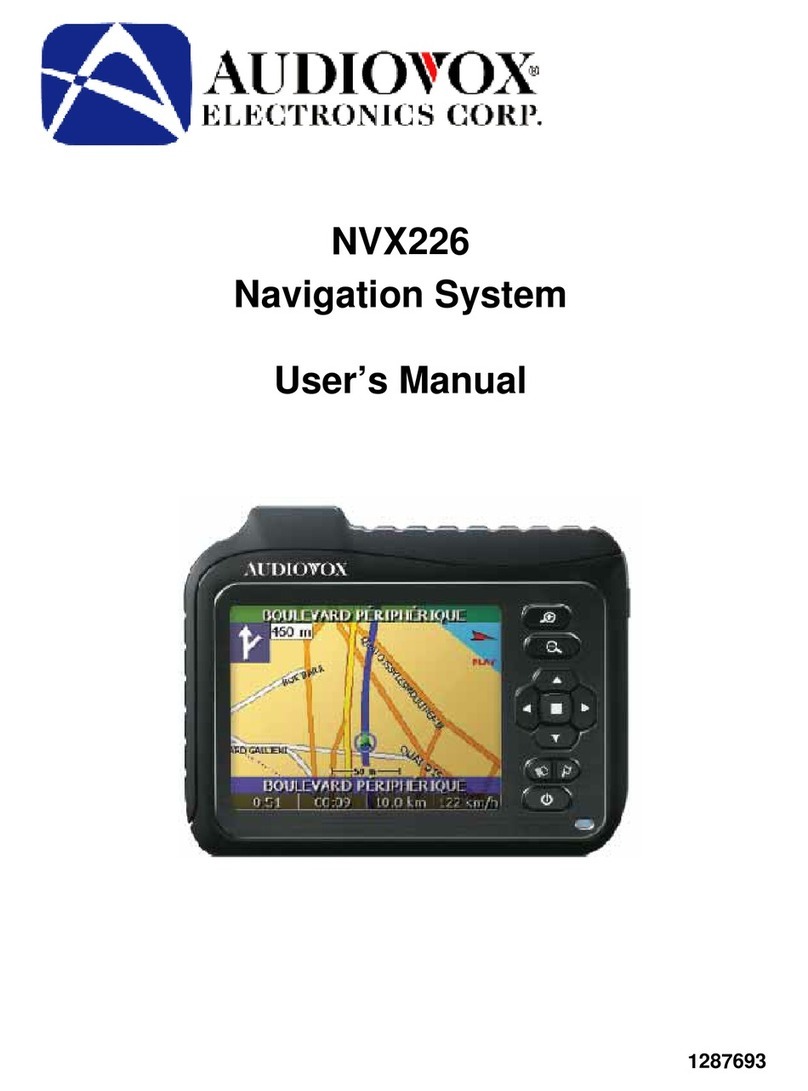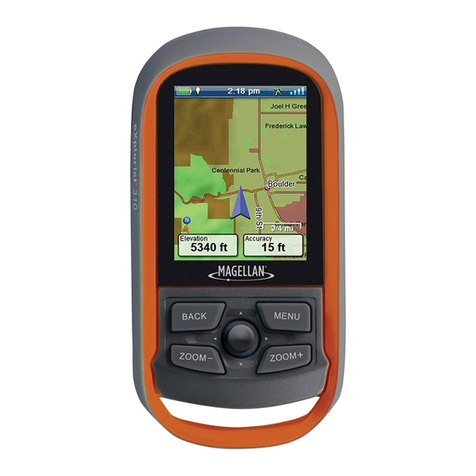EverMore EB-X315 User manual

EverMore Technology Inc.
2F, No.7, R&D Road 1, Science-Based Industrial Park, Hsinchu, Taiwan, 300, R.O.C. http://www.emt.com.tw
1
EB-X315
GPS Receiver Module
User’s Guide
EverMore Technology Inc.

EverMore Technology Inc.
2F, No.7, R&D Road 1, Science-Based Industrial Park, Hsinchu, Taiwan, 300, R.O.C. http://www.emt.com.tw
2
Manual Revision History
Revision Date Update Summary
Issue A October 2002 Initial release (Updated)
© EverMore Technology Inc. All rights reserved.
Not to be reproduced in whole or part for any purpose without written permission of EverMore
Technology Inc. Information provided by EverMore Technology Inc. is believed to be accurate
and reliable. However, no responsibility is assumed by EverMore Technology Inc. for its use.
EverMore Technology Inc. reserves the right to change specification at any time without notice.

EverMore Technology Inc.
2F, No.7, R&D Road 1, Science-Based Industrial Park, Hsinchu, Taiwan, 300, R.O.C. http://www.emt.com.tw
3
Table of Contents
1. INTRODUCTION..................................................................................................... 5
1.1. OVERVIEW ........................................................................................................ 5
1.2. FEATURES.......................................................................................................... 8
1.3. EVERMORE EB-X315 EVA L U AT I O N KIT ................................................... 9
1.4. RECEIVER MODULE OPERATION .................................................................. 9
2. HARDWARE INTERFACE................................................................................... 11
2.1. EB-X315 PICTURE........................................................................................ 11
2.2. DEVELOPMENT PLATFORM PICTURE ......................................................... 12
2.3. MECHANICAL DIMENSIONS......................................................................... 13
2.4. RF CONNECTOR............................................................................................. 13
2.5. INTERFACE CONNECTOR.............................................................................. 14
2.6. INTERFACE CONNECTOR PIN ASSIGNMENT.............................................. 15
2.7. PIO CONNECTOR PIN ASSIGNMENT .......................................................... 16
2.8. ONE-PULSE-PER-SECOND OUTPUT ........................................................... 17
3. SOFTWARE INTERFACE .................................................................................... 18
3.1. HOW TO DEVELOP AN EB-X315 USER PROGRAM ................................... 18
3.2. USER API........................................................................................................ 19
3.3. EB-X315 RESOURCES ................................................................................. 20
3.4. HOW TO DOWNLOAD USER PROGRAMS ..................................................... 21
3.5. HOW TO DEBUG USER PROGRAM ................................................................ 23
3.6. TROUBLESHOOTING ...................................................................................... 24
4. GPS OUTPUT MESSAGE..................................................................................... 25
4.1. NMEA OUTPUT MESSAGE SPECIFICATION ............................................. 25
4.1.1. GGA – Global Positioning System Fix Data .............................................. 26
4.1.2. GLL – Geographic Position – Latitude / Longitude ................................... 27
4.1.3. GSA – GNSS DOP and Active Satellites..................................................... 28
4.1.4. GSV – GNSS Satellites in View ................................................................... 29
4.1.5. RMC – Recommended Minimum Specific GNSS Data ............................... 30
4.1.6. VTG – Course Over Ground and Ground Speed ........................................ 31
4.2. EVERMORE BINARY MESSAGE SPECIFICATION .................................. 32
4.2.1. EverMore Binary Input Message 0x80: Initialization ................................ 33
4.2.2. EverMore Binary Input Message 0x81: Data Logging............................... 34

EverMore Technology Inc.
2F, No.7, R&D Road 1, Science-Based Industrial Park, Hsinchu, Taiwan, 300, R.O.C. http://www.emt.com.tw
4
4.2.3. EverMore Binary Input Message 0x86: Set Elevation Mask ...................... 34
4.2.4. EverMore Binary Input Message 0x87: Set DOP Mask ............................. 34
4.2.5. EverMore Binary Input Message 0x89: Set Operating Mode..................... 35
4.2.6. EverMore Binary Output Message 0x02: Navigation Data........................ 36
4.2.7. EverMore Binary Output Message 0x04: DOP Data ................................. 37
4.2.8. EverMore Binary Output Message 0x06: Channel Status .......................... 38
4.2.9. EverMore Binary Output Message 0x08: Measurement Data.................... 39
APPENDIX A. SYSTEM CONTROL PORT ADDRESS....................................... 40
A.1. REGISTER INPUT / OUTPUT FUNCTIONS................................................... 40
A.2. TIMER CONTROL .......................................................................................... 40
A.3. TIMER OUTPUT ............................................................................................. 44
APPENDIX B. SUPPORTED DATUM LIST .......................................................... 45
B.1. ELLIPSOID DESCRIPTION TABLE................................................... 52
APPENDIX C. DEFAULT VALUES......................................................................... 53

EverMore Technology Inc.
2F, No.7, R&D Road 1, Science-Based Industrial Park, Hsinchu, Taiwan, 300, R.O.C. http://www.emt.com.tw
5
1. Introduction
1.1. Overview
The EB-X315 GPS Module is intended for use in a wide range of applications where EB-X315
applies. The module simultaneously tracks up to twelve satellites, provides accurate satellite
positioning data with fast time-to-first-fix (TTFF) and low power consumption. In addition, with
all of the features of EBX-315, It has a very efficient dual-tasking kernel, which allows
applications to reside on the module and to control up to 9 on-board Input/Output pins. This
micro kernel provides high performance and maximum flexibility for a wide range of
applications including mobile asset tracking, in-vehicle automotive guidance, location sensing,
telematics and so on. The highly integrated receiver achieves high performance, minimizes
board size and power consumption requirements. The EB-X315 is designed to withstand harsh
operating environments; however, it should be used inside an enclosure as a part of the
application product designed by the system integrator.
As latest development in GPS, many applications have been introduced into the area where
the position of the source, receivers, for example, is no more the only one essential factor to
dominate the GPS market. They have been implicitly embedded into many modern information
products. However, this source still dominates the overall cost of the end products. The
majority of the cost is from the development:
1. Develop extra application control board separated from GPS module. Or
2. Link application code with GPS Baseband object code.
Although the first solution is purely independently from GPS kernel, (application developers do
not need to have GPS knowledge), an extra board will result in a bigger end product
dimension and also consume more battery power. On the contrary, the second solution makes
the application much complicated to develop. Developers might somehow need to learn the
system architecture of the original GPS kernel. In some situations, one might need to pay extra
money to get technical support or service from the GPS module provider, or they would break
down the GPS kernel.
To ease the problems the GPS end-product developers might meet, EverMore introduces the
EB-X315 engine board combined with an advanced GPS kernel and up to 10 control IO pins.

EverMore Technology Inc.
2F, No.7, R&D Road 1, Science-Based Industrial Park, Hsinchu, Taiwan, 300, R.O.C. http://www.emt.com.tw
6
By using EB-X315, developers can really concentrate on their GPS application software
design. EB-X315 enables developers to download their own GPS-aware program into the
80186-based platform and result in cost-efficient in whole user package. Users will be able to
fully use the power of 80186 without adding extra CPU to access various IO applications. The
EB-X315 package provides about 9 PIO pins for developers to control external devices and
retrieve signals from outside environment while getting position information from GPS kernel.
In addition, because all of the functionalities are within the same board, there is no need to
build up another control board.
The principle idea is that developers can develop their 80186 code with most of off-the-shelf
compilers, especially the code used in 8051 series, without any hassle on linking or
communicating with GPS kernel. Users simply recompile their 8051 programs with option
80186, (plus a little modification) and download into EB-X315 user code area. EB-X315
system will be able to locate and run user system automatically.
Figure 1. Architecture & Application Concept
EB X315 board
PIO
User
Program
GPS
Kernel
Download program or debugging
COM1
COM 2
VCOM
APIs
LCD
Wireless
Modem
External
Device

EverMore Technology Inc.
2F, No.7, R&D Road 1, Science-Based Industrial Park, Hsinchu, Taiwan, 300, R.O.C. http://www.emt.com.tw
7
Application developers will find the beauty of EB-X315 is that the interface between user
program and GPS is very clear and simple. Without any worry on breaking down GPS,
developers can focus on their applications as long as using EB-X315.

EverMore Technology Inc.
2F, No.7, R&D Road 1, Science-Based Industrial Park, Hsinchu, Taiwan, 300, R.O.C. http://www.emt.com.tw
8
1.2. Features
The EB-X315 GPS module offers following features:
For user program:
z Downloadable 96 K bytes User Flash memory and 48 K bytes SRAM
z 9 PIOs and up to 2 external interrupts
z Two on-board timers
z Real time clock
z Programmable on-board application program space
z Two on-board serial ports
For GPS Receiver
z 12 parallel tracking channels
z Fast TTFF and low power consumption
z Compact design suitable for applications requiring small space
z Differential correction using real-time RTCM SC-104 data
z On-board rechargeable battery sustained real-time clock and memory for fast satellite
reacquisition during power-up
z High accuracy one-pulse-per-second output
z Upgradeable firmware using flash-based program memory
z Supports NMEA-0183 protocol
z Full navigation accuracy achievable with Standard Positioning Service
z Optimized for navigation in urban-canyon environments
z Automatic cold start with no user initialization required

EverMore Technology Inc.
2F, No.7, R&D Road 1, Science-Based Industrial Park, Hsinchu, Taiwan, 300, R.O.C. http://www.emt.com.tw
9
1.3. EverMore EB-X315 Evaluation Kit
- 33 MHz EverMore GPS Engine Board (EB-X315)
- Power board with two COM ports
- Power Adaptor (Voltage 9V, Amp 1.5A)
- PC Download program
- EB-X315 User Guide
- User API for C Language
- C Development Guide
- Sample object Code for Turbo C and Microsoft C 8.0
- Release Note
1.4. Receiver Module Operation
Upon power up, EB-X315 micro kernel checks pin 6 to determine operation mode. If this pin is
logical high (default), the dual-tasking kernel will be launched. If this pin is logical low, only
GPS kernel is activated. This mode is good for the situation when user task causes CPU
exception. When dual-tasking kernel is enabled, user task is working in the way time-sharing
with GPS kernel.
After initial GPS self-test has completed, the EB-X315 will begin satellite acquisition and
tracking process. Under normal open-sky condition, position-fix can be achieved within
approximately 45 seconds (within 15 seconds if valid ephemeris data is already collected from
recent use). After receiver position has been calculated, valid position, velocity and time
information are transmitted through the on board serial interface.
The receiver uses the latest stored position, satellite data, and current RTC time to achieve
rapid GPS signal acquisition and fast TTFF. If the receiver is transported over a large distance
across the globe, cold-start automatic-locate sequence is invoked. The first position fix may
take up to five minutes searching the sky for the GPS signal. The acquisition performance can
be improved significantly if the host initializes the receiver with a rough estimate of time and
user position.

EverMore Technology Inc.
2F, No.7, R&D Road 1, Science-Based Industrial Park, Hsinchu, Taiwan, 300, R.O.C. http://www.emt.com.tw
10
As soon as GPS signal is acquired and tracked, the EB-X315 will transmit valid navigation
information through its serial interface. The default serial port is COM1, however, user task can
redirect this port to Virtual port (VCOM) from which user task can get access the navigation
data. The navigation data contains following information:
z Receiver position in latitude, longitude, and altitude
z Receiver velocity
z Time
z DOP error-magnification factor
z GPS signal tracking status
The EB-X315 will perform 3D navigation when four or more satellites are tracked. When three
or fewer satellites are tracked, altitude-hold is enabled using the last computed altitude and 2D
navigation mode is entered.
With signal blockage or rising and setting of the satellites, where a change in satellite
constellation used for position fix occurred, large position error may result. The EB-X315
incorporates a proprietary algorithm to compensate the effect of satellite constellation change,
and maintains an accurate smooth estimate of the receiver’s position, velocity, and heading.

EverMore Technology Inc.
2F, No.7, R&D Road 1, Science-Based Industrial Park, Hsinchu, Taiwan, 300, R.O.C. http://www.emt.com.tw
11
2. Hardware Interface
2.1. EB-X315 Picture
Picture 1. Top view of EB-X315 board (Enlarge)

EverMore Technology Inc.
2F, No.7, R&D Road 1, Science-Based Industrial Park, Hsinchu, Taiwan, 300, R.O.C. http://www.emt.com.tw
12
2.2. Development Platform Picture
Picture 2. EB-X315 Application Development platform (Enlarge)

EverMore Technology Inc.
2F, No.7, R&D Road 1, Science-Based Industrial Park, Hsinchu, Taiwan, 300, R.O.C. http://www.emt.com.tw
13
2.3. Mechanical Dimensions
Unit:mil
2800
2550
480
78.74
1350 RF 1600
78.74
Top View 1025
RFShield 177
250
45
290
Lateral View
Figure 2. Dimension of EB-X315
2.4. RF Connector
The RF connector is a 50 ohm straight MCX snap-on coaxial RF jack receptacle.

EverMore Technology Inc.
2F, No.7, R&D Road 1, Science-Based Industrial Park, Hsinchu, Taiwan, 300, R.O.C. http://www.emt.com.tw
14
2.5. Interface Connector
The interface connector is a dual row, straight 2x10 pin header; with
2.0mm pitch.
Battery
Pin 1
20 Pin Header
CPU8633 RF
Pin 20 PIO Connector Pin 1
Pin22
Figure 3. Layout of the EBX-315

EverMore Technology Inc.
2F, No.7, R&D Road 1, Science-Based Industrial Park, Hsinchu, Taiwan, 300, R.O.C. http://www.emt.com.tw
15
2.6. Interface Connector Pin Assignment
Pin Function Pin Function
1 Antenna Power 2 NC
3 Backup Power 4 Vcc
5 NC 6 PIO5
7 PIO6 8 PIO3
9 PIO4 10 GND
11 TXD0 12 RXD0
13 GND 14 TXD1
15 RXD1 16 GND
17 GND 18 GND
19 1PPS 20 1KPPS
The following is a functional description of the pins on the 20-pin interface connector.
Pin 1. Antenna Power : External active antenna power input
Pin 2. NC : No connection
Pin 3. Backup Power : External backup battery charge input.
Pin 4. Vcc : Power supply input, regulated 3.3V, 140mA
Pin 5. NC : No connection
Pin 6. PIO5 : reserved I/O port
Pin 7. PIO6 : reserved I/O port
Pin 8. PIO3 : reserved I/O port
Pin 9. PIO4 : reserved I/O port
Pin 10. GND : Ground
Pin 11. TXD0 : Serial port output # 1 (GPS navigation output)
Pin 12. RXD0 : Serial port input # 1 (command input, pull high or low if unused)
Pin 13. GND : Ground
Pin 14. TXD1 : Serial port output #2 (currently unused)
Pin 15. RXD1 : Serial port input #2 (DGPS input, pull high or low if not used)
Pin 16. GND : Ground
Pin 17. GND : Ground
Pin 18. GND : Ground
Pin 19. 1PPS : 1-pulse-per-second output. Active high for approx. 1usec
Pin 20. 1KPPS : 1000-pulse-per-second output. Active high for approx. 1usec

EverMore Technology Inc.
2F, No.7, R&D Road 1, Science-Based Industrial Park, Hsinchu, Taiwan, 300, R.O.C. http://www.emt.com.tw
16
2.7. PIO Connector Pin Assignment
- PIO 2, 3, 4, 5, 20, 21, 24, 25 and 30 are available on the standard version.
- INT3 and INT4 (shared with PIO 30) are available for setting up as interrupt sources.
Available PIO vs. Pin #
PIO 2 3 4 5 20 21 24 25 30 / INT 4 INT 3
Pin # 9 11 13 15 10 12 14 16 22 20
- To configure those PIOs, please see API file, usrif.h, for detail.
- To setup interrupt service routine for INT3 or INT4, there are some macros having been
defined in API file, usrif.h, for control those interrupts.
- The following table shows all of the signals on the PIO header.
PIN Name Available for
user control
1 AU44 -
2 AU45 -
3 DVCC -
4 Ground -
5 T1In -
6 CTS1 -
7 T1Out -
8 RTS1 -
9 PIO 2 Yes
10 PIO 20 Yes
11 PIO 3 Yes
12 PIO 21 Yes
13 PIO 4 Yes
14 PIO 24 Yes
15 PIO 5 Yes
16 PIO 25 Yes
17 T0Out -
18 1 PPS -
19 DRQ 0 -
20 INT 3 Yes
21 DRQ 1 -
22 INT 4 / PIO 30 Yes

EverMore Technology Inc.
2F, No.7, R&D Road 1, Science-Based Industrial Park, Hsinchu, Taiwan, 300, R.O.C. http://www.emt.com.tw
17
2.8. One-Pulse-Per-Second Output
The one-pulse-per-second output is provided for applications requiring precise timing
measurements. The output pulse is 1usec in duration. The rising edge of the output pulse is
accurate to +/-1usec with respect to the start of each GPS second. The accuracy of the
one-pulse-per-second output is maintained only when the receiver has valid position fix.

EverMore Technology Inc.
2F, No.7, R&D Road 1, Science-Based Industrial Park, Hsinchu, Taiwan, 300, R.O.C. http://www.emt.com.tw
18
3. Software Interface
3.1. How to develop an EB-X315 user program
Powered by an advanced micro scheme implemented in GPS kernel, EB-X315 is
designed to accommodate both GPS kernel and user application working together on the
same board without adding any hardship on the user development cycle. At this time,
users can design their applications with least limitation and understanding of GPS
firmware.
Here is a small set of the guidelines, which put user programs on the track of the micro
scheme:
- Program starting entry: 0xC0000 (Code segment: 0xC000, Offset: 0x0)
- Data starting address: 0x14000 (Data Segment: 0x1400, Offset: 0x0)
- Using Medium model compilation for user code and associated libraries.
- Some limitations on calling library functions should be applied to interrupt service
routines (ISR).
- 16-bit CPU (with 80186 instruction set).
- User program should be a complete 80186 program, which contains a startup code
to initialize its own stack and data segment.
- Stack size at least 8 KB.
- Share CPU time with GPS kernel. Please keep it in mind that user program is
running less priority than GPS kernel. Part of the CPU time will be used by position
computation on GPS kernel. EB-X315 is designed to target on IO control-oriented
applications with less computation.
- If the compiler tool is not an embedded one (e.g. Turbo C), user should use as few of
the compiler's run-time library functions as possible. Because most of the functions in
run-time library are calling DOS or BIOS functions, and to support those functions,
user might need extra work on startup (initial) code.

EverMore Technology Inc.
2F, No.7, R&D Road 1, Science-Based Industrial Park, Hsinchu, Taiwan, 300, R.O.C. http://www.emt.com.tw
19
3.2. User API
Developers can find the definitions for the following APIs in C header file usrif.h. To access
those APIs, please use the macros defined inside this file for better compatibility with the
future versions. Please refer to the document “EB-X315 Application Program Interface for
C” and C header file usrif.h for detail and API explanation.
- Set interrupt mask/ interrupt vector
- Read RTC
- Setup serial port configuration
- Send/receive data through Serial ports
- Set GPS operation mode
- Set GPS stationary mode
- Setup/control/read PIOs.
- User sleep function.
- Change GPS data output port.
- Reset

EverMore Technology Inc.
2F, No.7, R&D Road 1, Science-Based Industrial Park, Hsinchu, Taiwan, 300, R.O.C. http://www.emt.com.tw
20
3.3. EB-X315 Resources
Two on-board timers
Each is associated with a timer interrupt
9 Programmable IOs + 1 external interrupt
Pin 22 (PIO 30) can be programmed to be another external interrupt
source in normal mode. (See table below)
Real time clock
Three COM ports:
- VCOM (Virtual COM) – to communicate with GPS system.
- COM 2 (User COM) – Provide extra communication for user to talk to other devices
through serial link (e.g. wireless modem)
- COM 1 (D-COM) - Used for debugging and downloading user program.
User Memory Partition:
- 96 KB Flash Memory in standard version is reserved for user program, starting at
address 0xC0000 and ending at 0xD7FFF. Flash memory is organized as
several sectors in size 4 KB for each. User can call API to save data into flash
memory. However, users have to put the user program entry at the
address 0xC0000 from which EB-X315 kernel knows how to start user
program.
- 48 KB battery-backup SRAM in standard version is reserved for users, starting at
0x14000 and ending at 0x1FFFF
Table of contents
Other EverMore GPS manuals

EverMore
EverMore SA-320 User manual
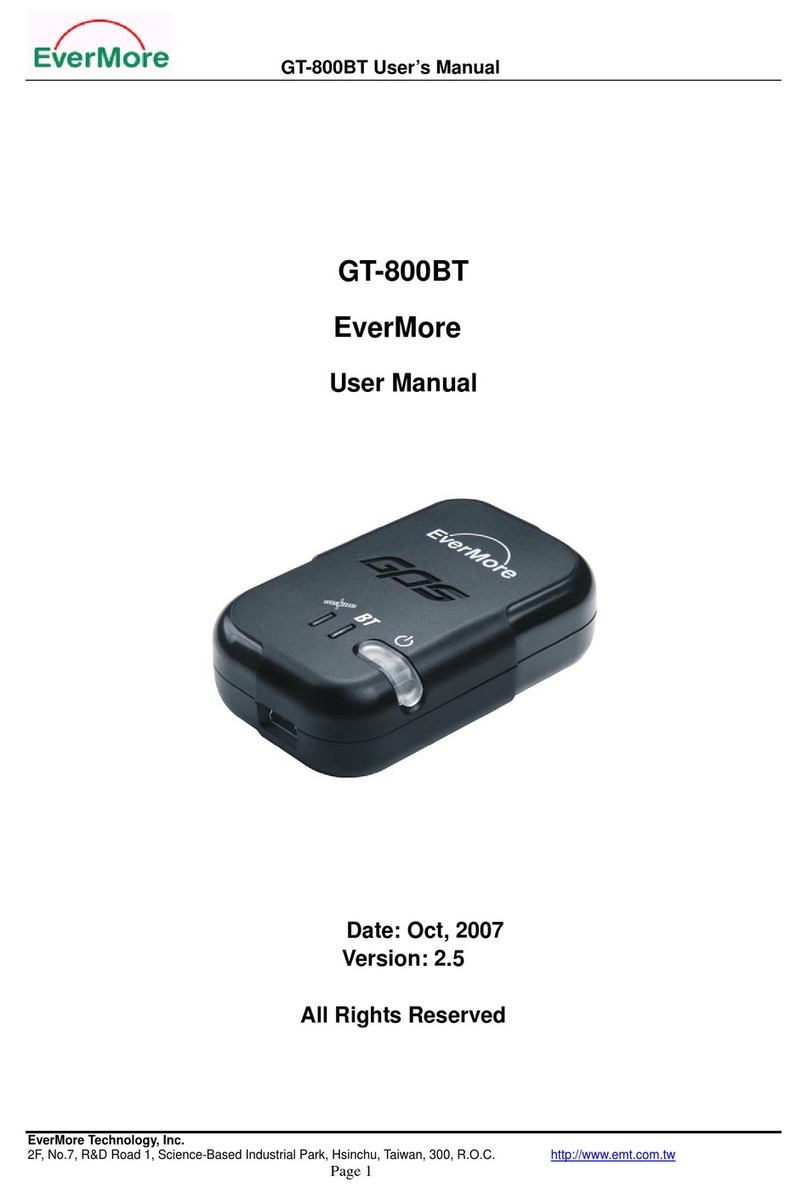
EverMore
EverMore Switch & PoE Splitter User manual
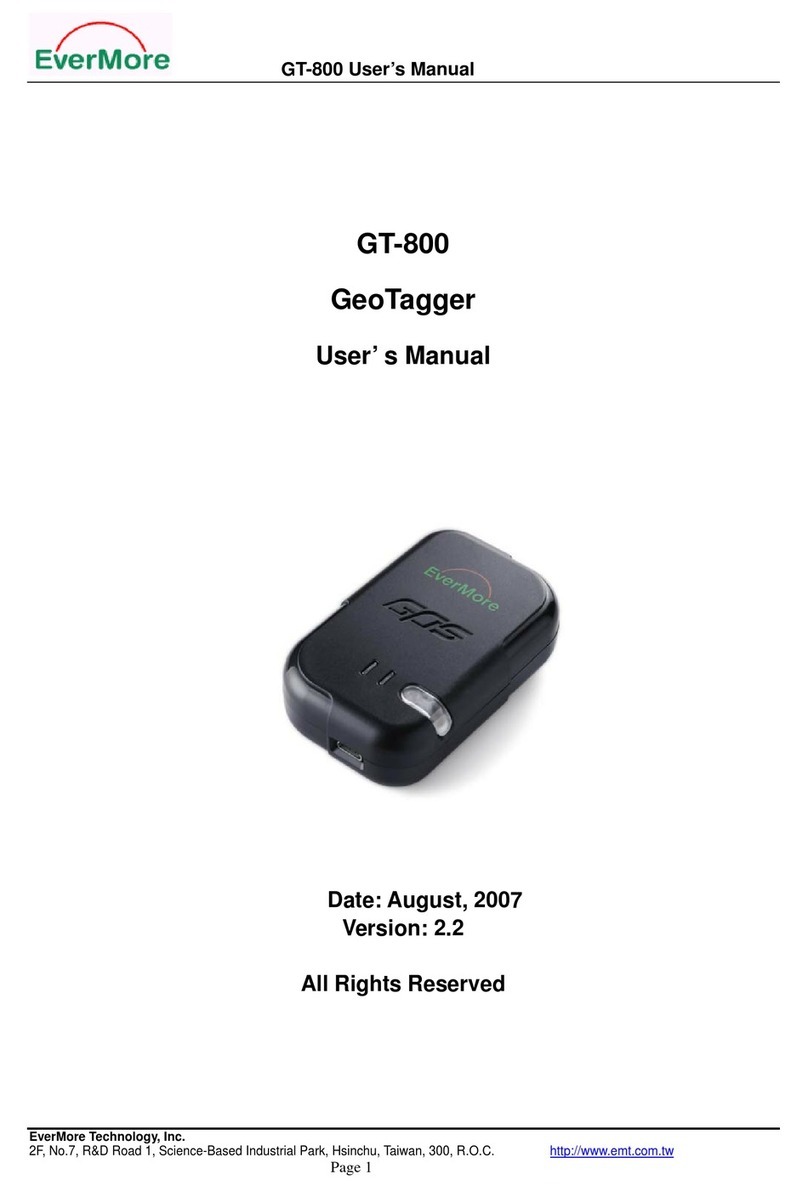
EverMore
EverMore GeoTagger GT-800 User manual
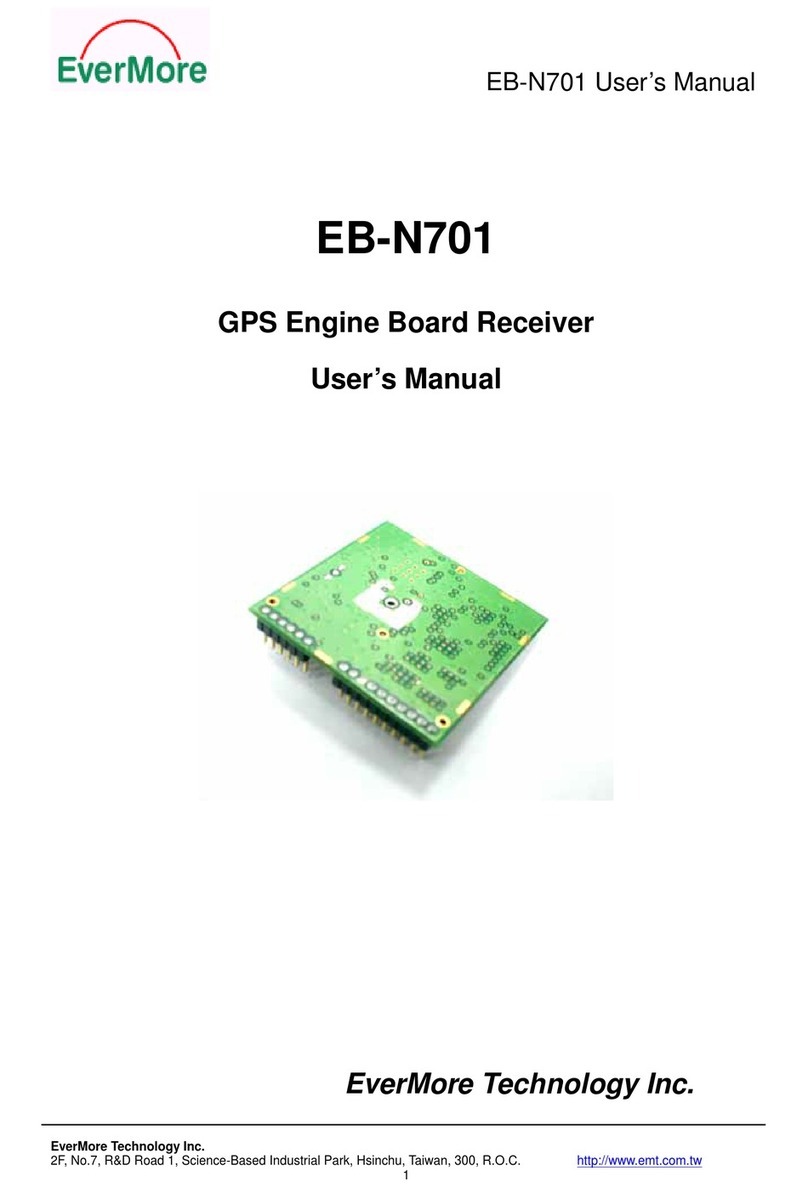
EverMore
EverMore EB-N701 User manual
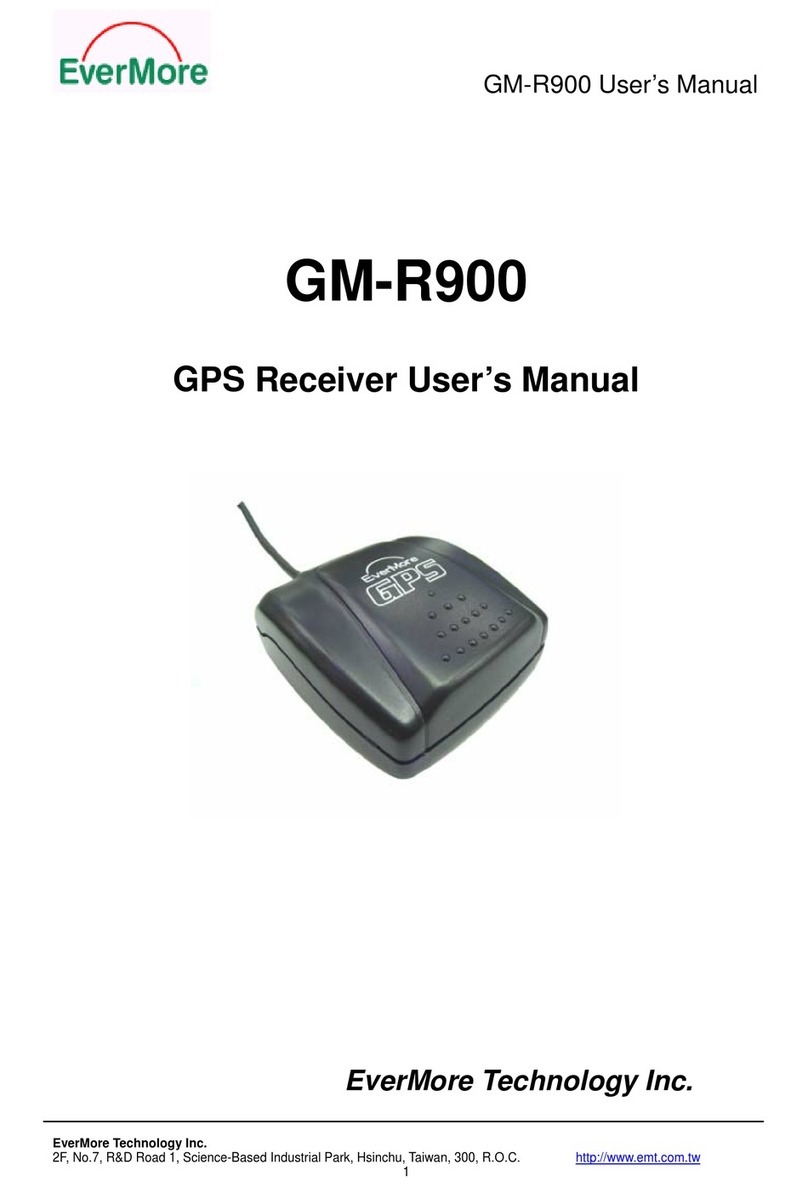
EverMore
EverMore GM-R900 User manual
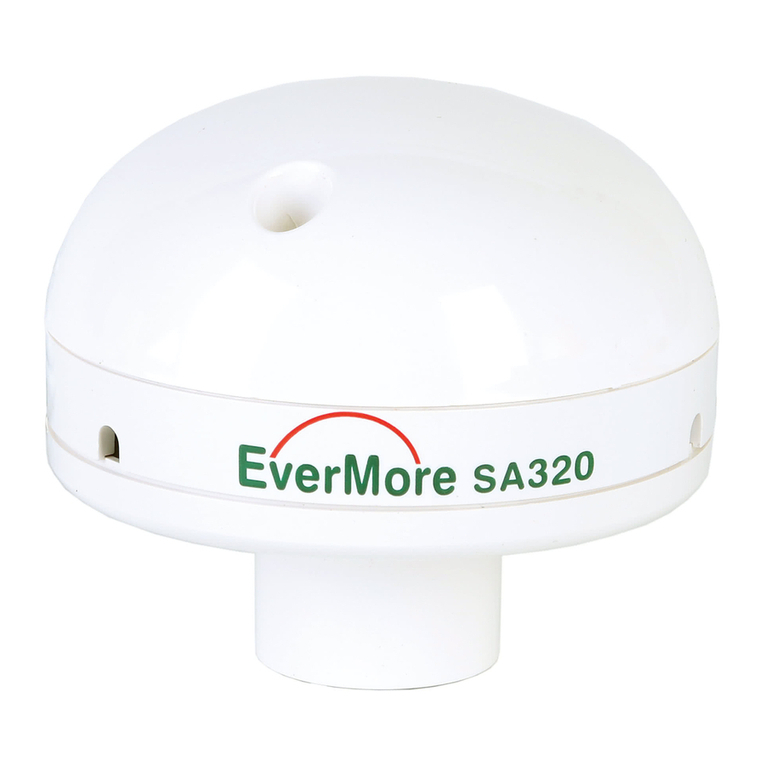
EverMore
EverMore SA-320 User manual
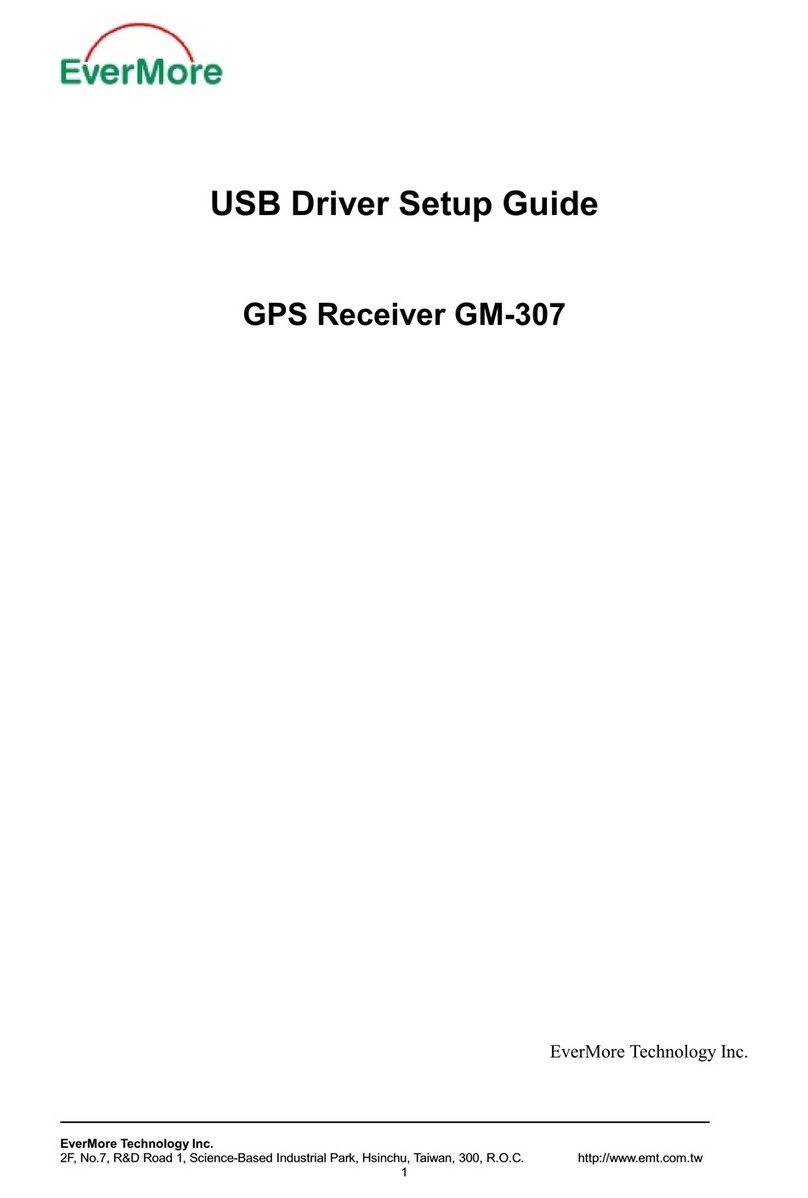
EverMore
EverMore GM-307 User manual
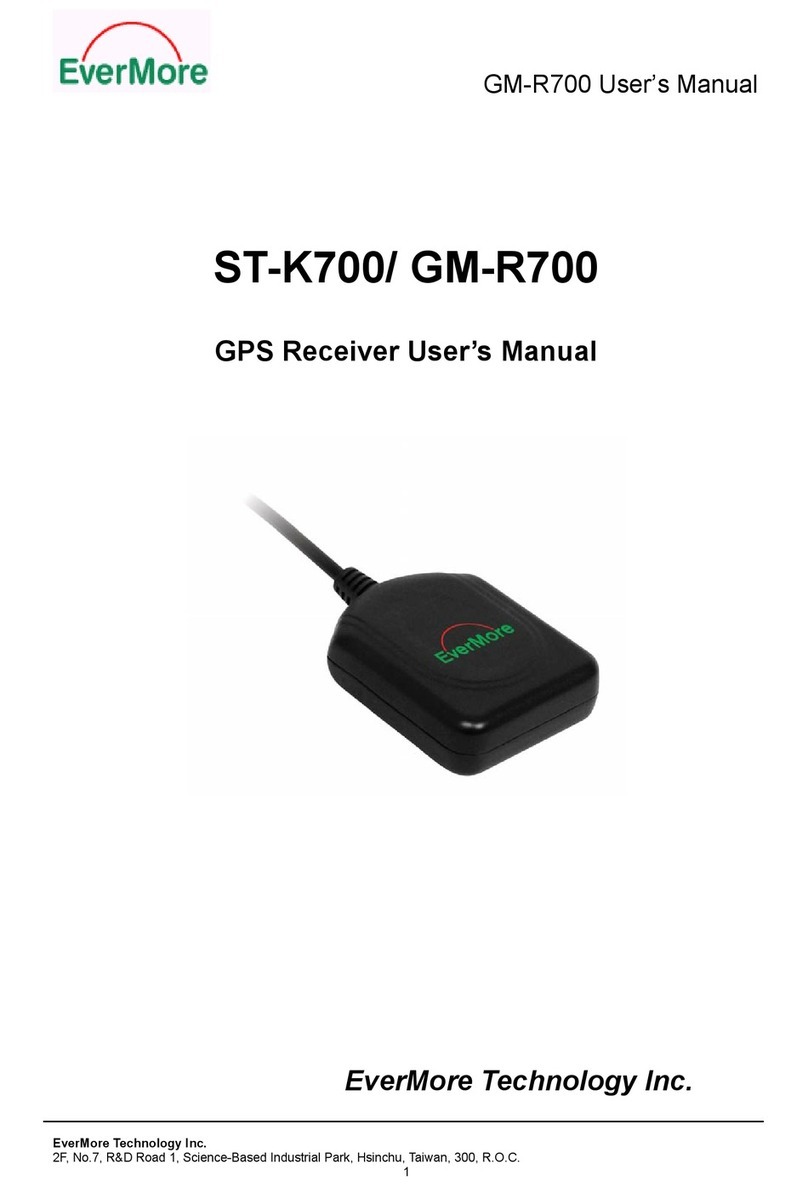
EverMore
EverMore ST-K700 User manual
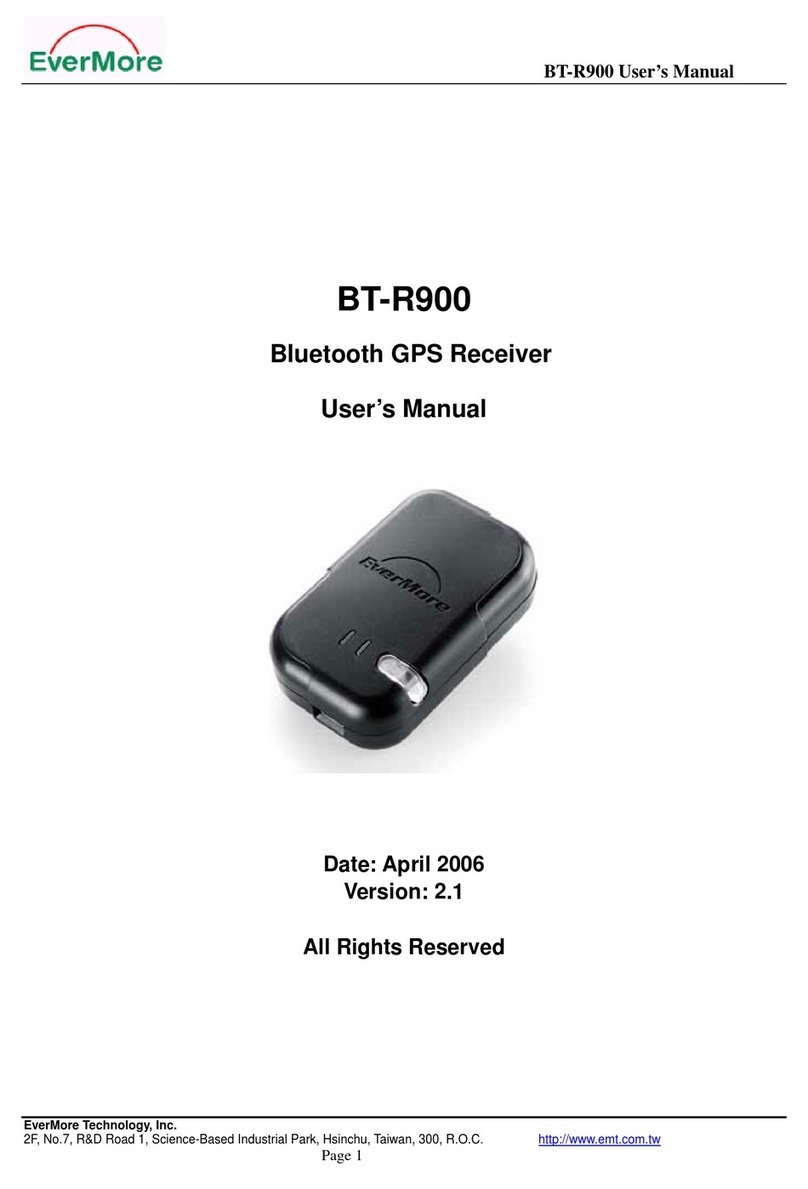
EverMore
EverMore BT-R900 User manual
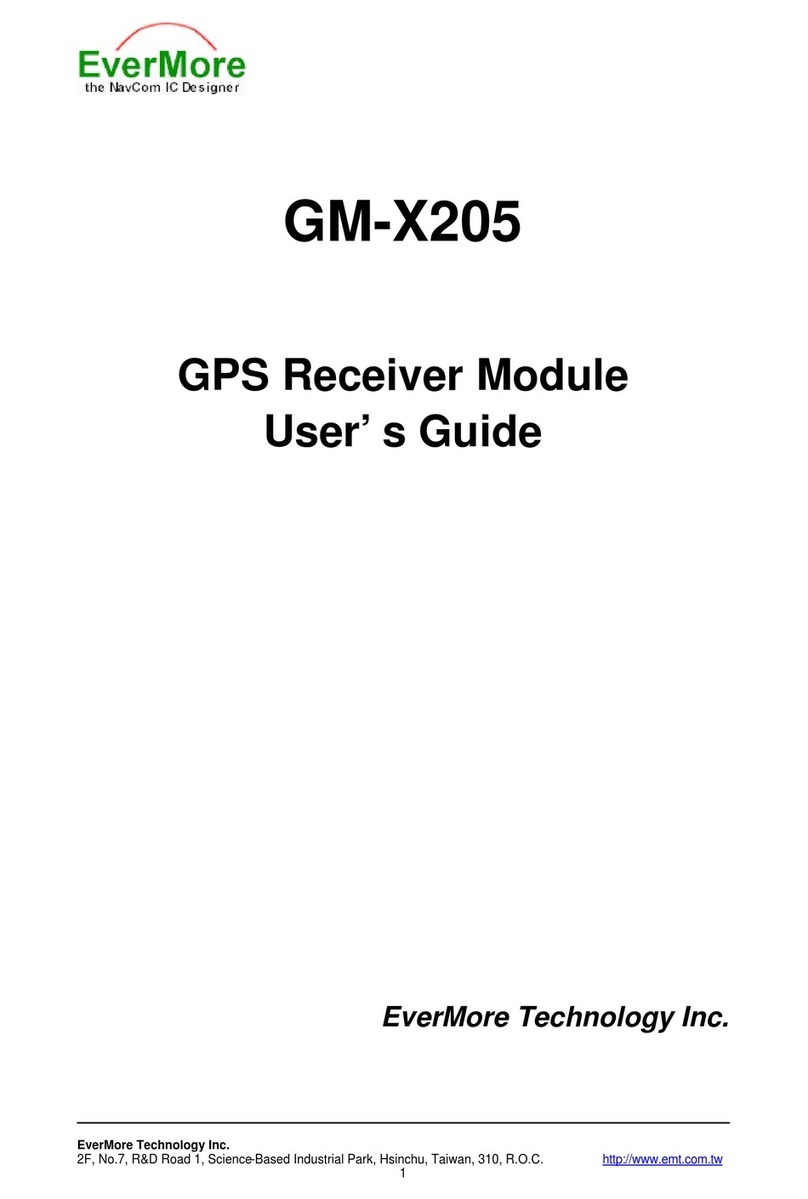
EverMore
EverMore GM-X205 User manual
Popular GPS manuals by other brands

Milwaukee
Milwaukee One-Key 48-21-2301 quick start guide
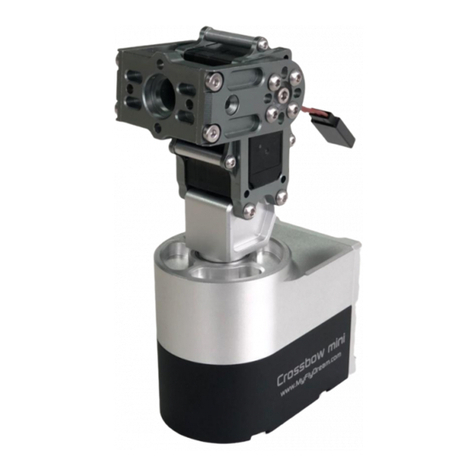
MyFlyDream
MyFlyDream Mini Crossbow manual
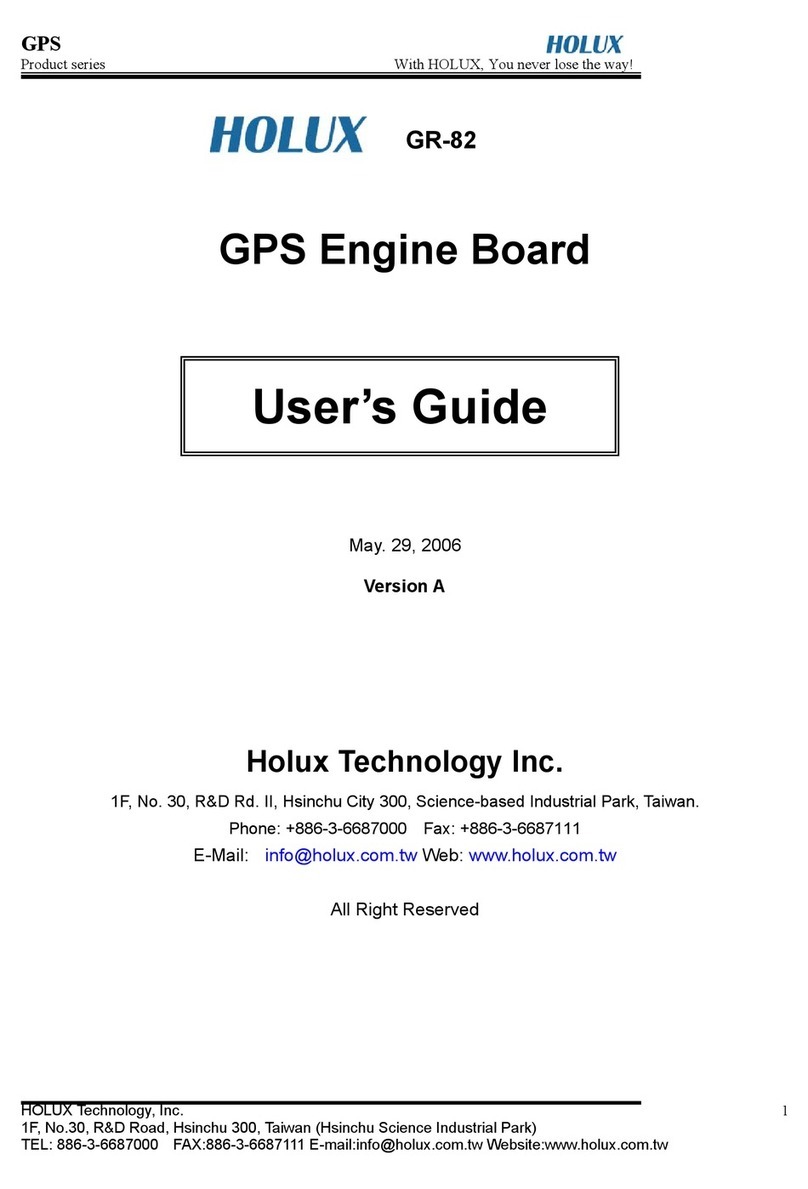
Holux
Holux GR-82 user guide
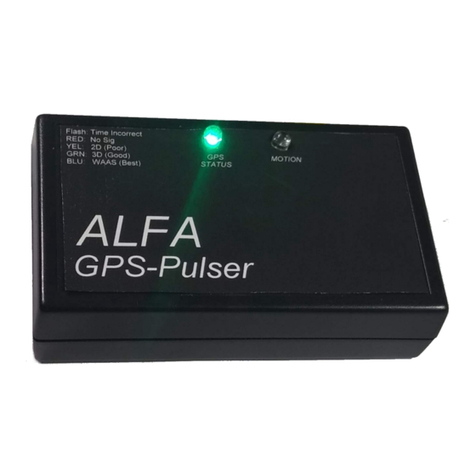
Small Systems Specialists
Small Systems Specialists ALFA GPS-Pulser owner's manual
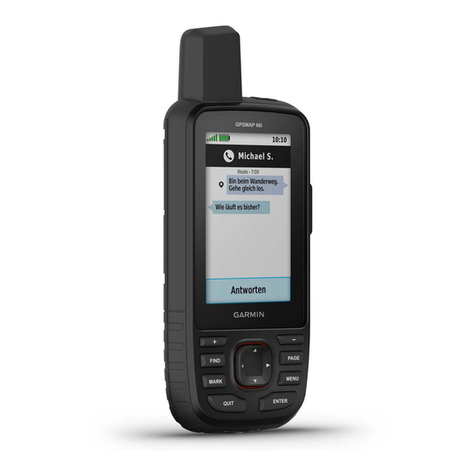
Garmin
Garmin GPSMAP 66i owner's manual
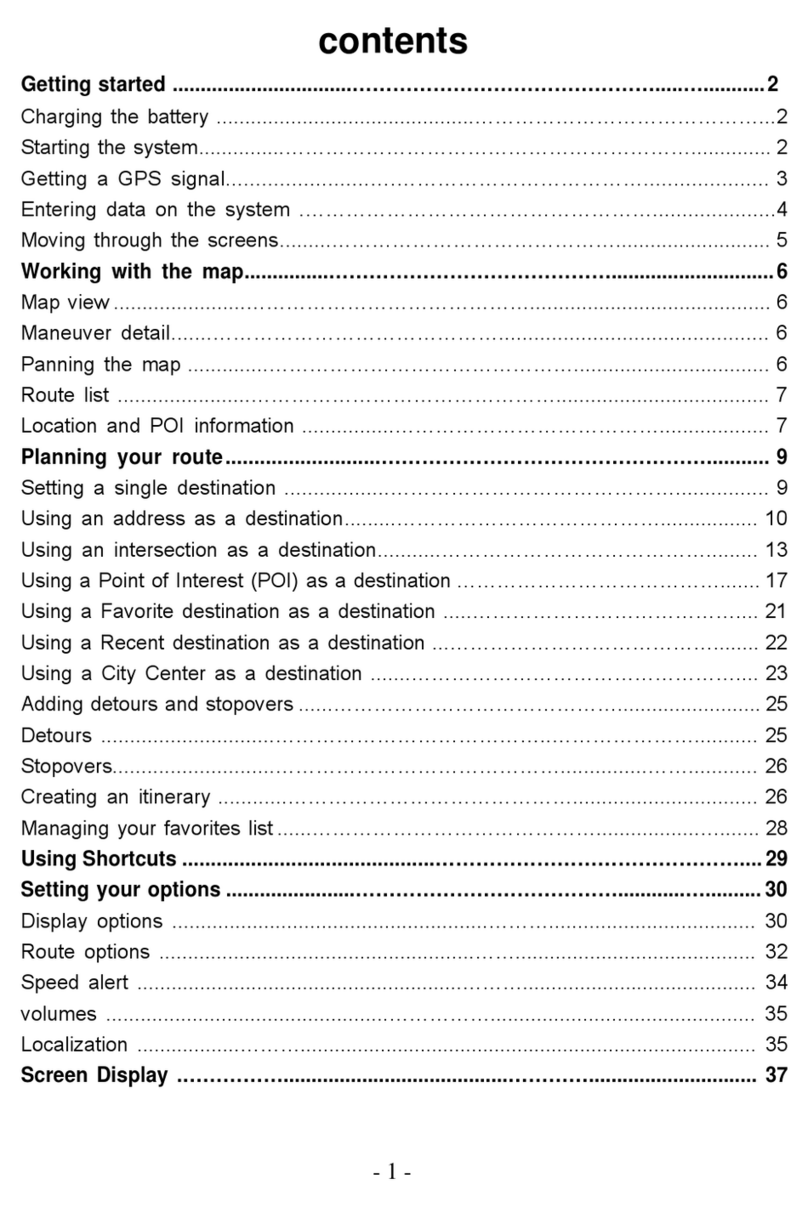
Nextar
Nextar W3 - 3.5 Inch Color Touch Navigation System manual
